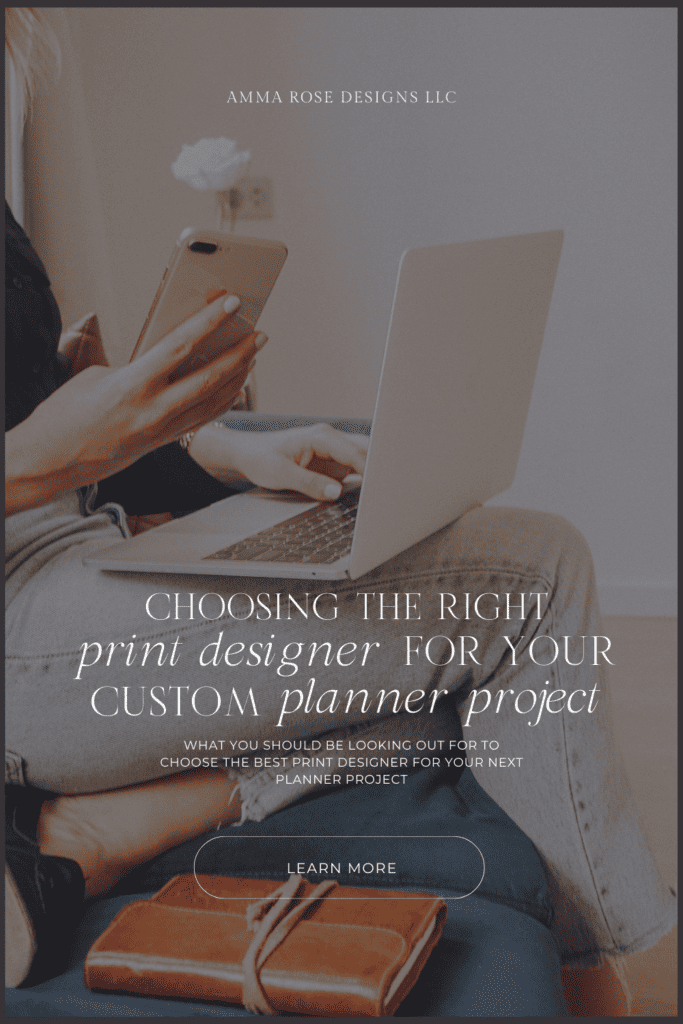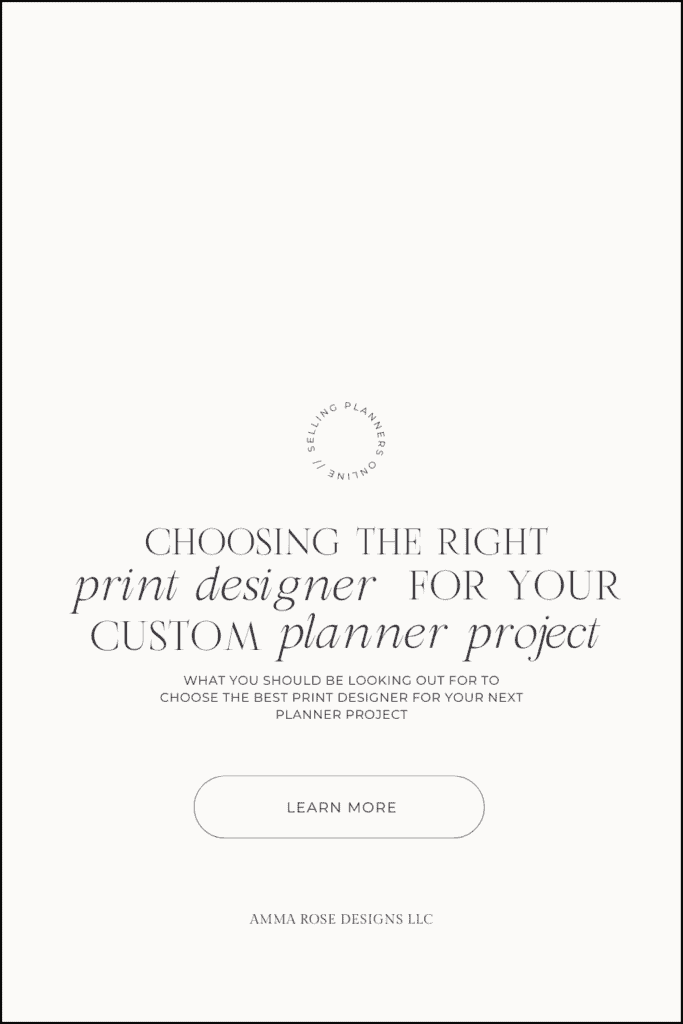
How to Choose a Print Designer for Your Next Planner Project
So, you’ve decided to create a planner for your brand – that’s fantastic! Planners are more than just paper and ink, they’re a representation of your brand, a tool for your customers, and a beacon of your industry knowledge. A well-crafted planner can be a game-changer, helping to enhance organization, boost productivity, and even elevate your brand’s visibility.
But, let’s face it, creating a planner is no walk in the park. It’s not just about picking pretty colors or trendy fonts – it’s about strategic planning, functionality, and meticulous design. And that’s precisely where a professional print designer comes into the picture.
Choosing the right designer can be the difference between creating a planner that’s “just okay” and one that’s truly exceptional – one that not only looks appealing but also serves its purpose effectively.
In this blog post, we’ll guide you through the process of selecting the perfect print designer for your planner project. So, buckle up and let’s start this exciting journey together!
Related Post: Behind the Scenes: What I Do as a Planner Graphic Designer
01 | Assessing the Designer’s Style and Experience
One of the first things to consider when hunting for the right designer is their design style. Much like people, designers each have their own unique flair and flavor. This is why it’s so essential to check out a designer’s portfolio before hopping on board. If their style resonates with you and aligns with your brand’s image, then you’re on the right path!
Now, you might be thinking, “A designer is a designer, right?” Well, not exactly. While all squares are rectangles, not all rectangles are squares, and the same principle applies here. Not all graphic designers are print designers.
Graphic design and print design, though closely related, are two different beasts. A print designer understands the intricacies of creating a design that translates well when printed. They take into account aspects like color accuracy, print bleed, binding styles, paper choices – elements that are often overlooked by a purely digital-focused graphic designer. For a planner project, which ultimately lives in the physical world, you want a print designer in your corner.
For those of you who prefer digital planning, having a print designer on your side is also beneficial, because a lot of the components of print design translates over to digital planners as well.
So, don’t shy away from asking potential designers about their experience in print design specifically. Remember, your planner deserves the very best, and that starts with choosing a designer who truly knows the ropes of the print world.

02 | Evaluating Expertise and Past Success
There’s a familiar saying, “Don’t judge a book by its cover,” but when it comes to planners, the cover—and what’s inside—counts a great deal. It’s one thing to create a beautiful planner, but it’s an entirely different game to design a planner that actually sells. The trick is in striking a balance between form and function, beauty and utility.
But how can you tell if a designer is capable of this?
Start by asking them some hard-hitting questions. Enquire about their approach to designing a planner. How do they ensure it’s both attractive and practical? Do they understand what makes a planner not just usable, but indispensable to its owner? Don’t be afraid to ask for examples of their previous work, especially designs that have successfully sold in the market.
Experience is invaluable in the print design world, and the designer’s track record can be a solid indicator of their skills. Have they—or their clients—had success selling planners in the past? Do they have testimonials or case studies to back up their claims?
Remember, a planner is more than a bundle of pages. It’s a tool that can change the way your customers organize their lives. Having a designer who has had firsthand success selling planners means they know what works. They understand how to create a product that doesn’t just look good on a shelf but becomes an essential part of a customer’s daily routine.
Choosing a designer with proven expertise and a history of success isn’t just a smart move—it’s an investment in the potential success of your planner project.
03 | Pricing Considerations
Alright, let’s dive into a topic that is often a deciding factor: pricing. We know it’s important, but it’s not just about finding the cheapest option. You need to consider what you’re getting for your money.
When reviewing a designer’s pricing, it’s worth noting that more experienced designers, particularly those with a large portfolio and positive feedback from previous clients (aka “social proof”), may charge higher rates. Why, you ask? Because they’ve proven their worth. They’ve shown time and time again that they can deliver top-notch, successful designs that resonate with audiences and boost sales.
Next, let’s discuss the difference between flat rates and project-specific quotes. Both have their merits and can be the right fit depending on your project and budget.
Flat rates are straightforward and simple. You know exactly what you’re paying from the get-go, which makes budgeting a breeze. However, with a flat rate, there’s a risk that your project’s unique needs might not be fully accounted for. For example, you could end up paying the same rate for a 10-page planner as someone else would for a 50-page planner, which may not feel like you’re getting the best value.
On the flip side, a project-specific quote takes into account the unique details of your project, from its scope to its complexity. This means the price you’re quoted accurately reflects the work involved. While this might mean a higher price tag, it also means your project gets the attention and time it deserves to truly shine.
In the end, remember that the cost of a professional planner designer is an investment in your project’s success. You’re not just paying for a product, you’re paying for expertise, experience, and a design that will captivate your audience. So consider carefully, weigh your options, and choose a pricing structure that aligns with your needs and budget.
04 | Service Type: VIP Week vs Project-Based
Let’s now touch upon the different service types that a planner designer might offer: VIP Design Week and project-based services. Each has its own set of pros and cons and understanding them will help you decide which suits your needs best.
First up, we have the VIP Design Week. Picture this: A dedicated designer working on your planner, with your project being their sole focus for an entire week. Sounds great, right? In this fast-paced service type, your planner goes from concept to completion in just seven days. This service is ideal if you’re in a rush or have a tight deadline to meet.
But there’s a flip side to this speedy service. The limited time frame can potentially constrain the creative process. Designing a unique, fully-functional planner that truly resonifies with your audience usually requires thoughtful consideration, meticulous planning, and iterative development. Furthermore, with VIP Week’s flat rate, you may end up paying the same amount for a smaller project as someone else does for a larger one.
This is where project-based services come into play. In this model, pricing, deadlines, and deliverables are tailored specifically to your project. The designer estimates the time and effort your unique project requires, ensuring it gets the attention and development it needs. This can take anywhere from two weeks to over a month, depending on the project’s complexity.
The project-based approach offers flexibility and fairness. Whether you have a 10-page or a 50-page project, you can rest assured knowing that the quote you receive is reflective of your project’s specific requirements.
In summary, while VIP Week offers a fast turnaround, project-based services provide a customized, fair approach to your planner design. Weigh the pros and cons of each, consider your project’s size and deadline, and choose the service type that’s best aligned with your needs.
How to Find a Print Designer for Your Next Planner Project
Finding the right designer for your planner project may feel like looking for a needle in a haystack, but with the right resources, it doesn’t have to be. Today’s digital age offers a multitude of platforms and resources where you can find talented print designers at your fingertips.
Popular freelancing platforms such as Fiverr and UpWork are treasure troves of talented individuals with diverse skill sets. These platforms allow you to sift through countless designers, view their portfolios, read client reviews, and choose the one that resonates with your vision.
Don’t underestimate the power of a good recommendation, either. If you know someone who has had a great experience with a print designer, consider reaching out to them for a referral. Word of mouth is an age-old method, yet it remains one of the most effective ways to find reliable services.
Another often overlooked method is to check if the planners you use and love offer design services. If a particular planner layout works seamlessly for you, chances are, the designer behind it will be able to replicate that success for your custom planner.

But before you dive into your search, allow me to offer a more straightforward solution. As a certified Print Production Professional and Graphic Designer, I take immense pleasure in turning your visions into a tangible, functional planner. I don’t just create planners – I craft solutions to your everyday challenges and bring your ideas to life. If you’d like to see how we can work together to design your dream planner, I invite you to check out my portfolio and select a package to get started. After all, the journey to a beautifully designed planner starts with a single step, or in this case, a simple inquiry.
Remember, choosing the right print designer for your planner project is a significant decision. Take your time, ask the right questions, and don’t be afraid to explore all available resources. Your perfect print designer is out there, and I hope you find the fit that’s just right for you.



